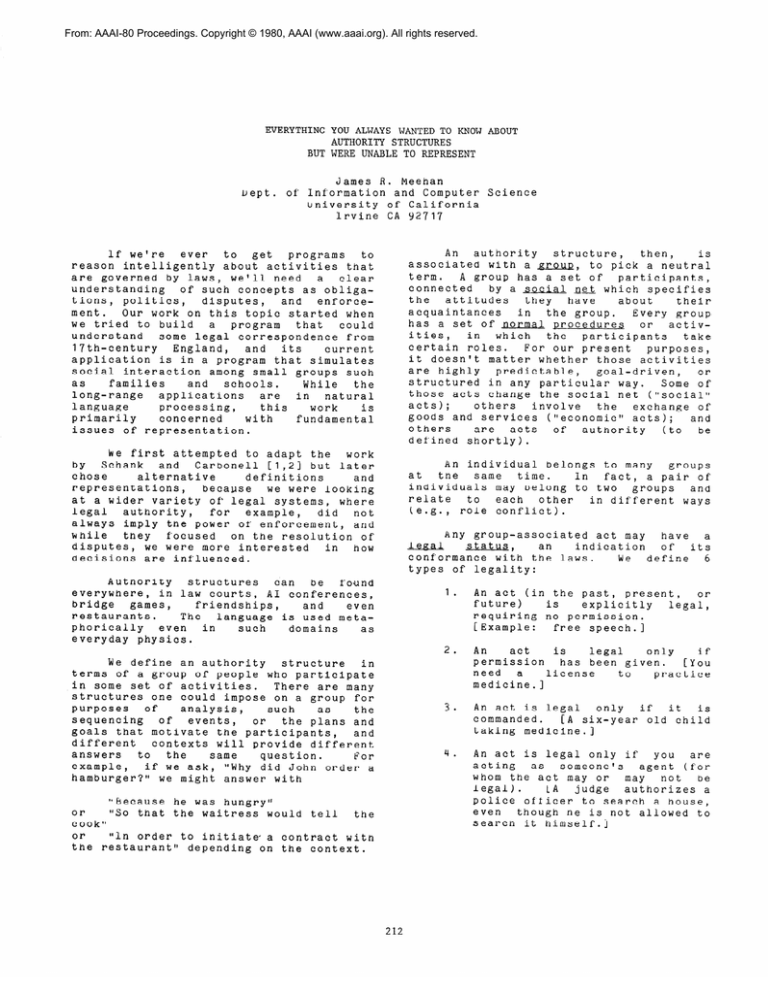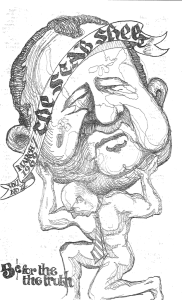
From: AAAI-80 Proceedings. Copyright © 1980, AAAI (www.aaai.org). All rights reserved.
EVERYTHING YOU ALWAYS WANTED TO KNOW ABOUT
AUTHORITY STRUCTURES
BUT WERE UNABLE TO REPRESENT
uept.
James R. Meehan
of Information
and Computer
university
of California
lrvine CA 92717
Science
An
authority
structure,
then,
is
with a aroun
to pick a neutral
term.
A group has a se; of
participants,
connected
by a social
set which specifies
the
attitudes
they
have
about
their
acquaintances
in
the group.
Every group
has a set of normal Drocedures
or
activities,
in which
the
participants
take
certain roles.
For our present
purposes,
it doesn't matter whether those activities
are highly
predictable,
goal-driven,
or
structured
in any particular
way.
Some of
those acts change the social net ("social"
acts);
others
involve
the
exchange of
goods
and services ("economic"
acts);
and
others
are
acts
of
authority
(to
be
defined shortly).
If we're
ever
to
programs
to
get
reason intelligently
about activities
that
are governed by laws,
we’ll
need
a
clear
understanding
of such concepts as obligations, politics,
disputes,
and
enforcement.
Our work on this topic started when
we tried to build
a program
that
could
understand
some legal correspondence
from
l'i'th-century England,
and
its
current
application
is in a program that simulates
social
interaction
among small groups such
as
families
and
schools.
While
the
long-range
applications
are
in
natural
language
processing,
this
work
is
primarily
concerned
with
fundamental
issues of representation.
associated
we first attempted
to adapt the
work
Schank
and
Carbonell
[I,21
but later
by
chose
alternative
definitions
and
representations,
because
we were looking
at a wider variety of legal systems, where
legal
authority,
for
example,
did
not
always imply the power of enforcement,
and
while
they
focused
on the resolution
of
disputes,
we were more interested
in
how
aecisions
are influenced.
An individual
belongs to many
groups
at
tne
same
time.
In
fact, a pair of
individuals
may Delong to two
groups
and
relate
to
each
other
in different ways
(e.g., role conflict).
Any group-associated
act may
have
a
legal
status,
an
indication
of
its
conformance
with the laws.
We
define
6
types of legality:
Authority
structures
can
be
found
everywhere,
in law courts, AI conferences,
bridge
games,
friendships,
and
even
restaurants.
The
language is used metaphorically
even
in
such
domains
as
everyday physics.
We define an authority
structure
in
terms of a group of people who participate
in some set of activities.
There are many
structures
one could impose on a group for
purposes
of
analysis,
such
as
the
sequencing
of
events,
or
the plans and
goals that motivate the participants,
and
different
contexts will
provide different
answers
to
the
same
question.
For
example,
if we ask, "Why did John order a
hamburger?"
we might answer with
'-because he was hungry"
or
"So that the waitress would tell
the
cook"
or
"In order to initiate a contract with
the restaurant"
depending on the context.
212
1.
An act (in the past, present,
or
future)
is
explicitly
legal,
requiring
no permission.
[Example:
free speech.]
2.
An
act
is
legal
only
.
permission
has been given.
[YiG
need
a
license
to
practice
medicine.]
3.
An act is legal
only
if
it
is
commanded.
[A six-year old child
taking medicine.]
4.
An act is legal only if
are
YOU
acting
as
someone's
agent (for
whom the act may or
not
be
may
legal).
LA
judge
authorizes
a
police
officer to search a house,
even
though ne is not allowed to
searcn it himse1f.j
5.
An act is legally required.
LIn
must follow suit if
bridge,
YOU
you can.1
6.
forbidden.
explicitly
An act is
[You may not submit more than one
paper to this conference.]
Autnority
are
often
structures
emoeaaea
in
one
anotner, and if a group
governing
certain
actions,
has no rules
then
it may
inherit
the
rules from an
r'or
example,
a
embeaaing
structure.
is an embedded system specifying
Gontract
The
little more than mutual obligations.
embedding
system
takes
care of the rest.
You
embedding
is not universal,
however.
sue
your
friends
if they fail to
can't
show up for an invited dinner.
Of the many possible states, some are
of
concern to the law, such as ownership,
claim
legal responsibility,
and right
of
or injury).
eisputes
are questions
(debt
act
either about
the legal
status
of some
file a tax return by
LAm
1 required
to
or
April lbtn if l'm getting
a refund?]
the trutn value of some law-relatea
a bout
state
LThe defendant pleaded not guiltyJ.
'The t'primitivesll
acts
of
In general, your power within a group
"make
is
measured
by
your
ability
to
things happen," to cause social, economic,
You
legal,
or
other
kinds
of actions.
incur a debt when someone acts to increase
power,
and
it is expected that you
your
will
though
not
necessarily
in
reply,
for
kind.
A
bribe,
example,
is
an
exchange
of
economic
power
for
(money)
legal power (position of authority).
authority
are:
1.
legal
to define
or
decide
the
to
status
of
an
act, according
such
the six types listed above,
as commanding
or obliging someone
to do something
[Clean
up
your
room]
many activities
call
for decisions
to
Some
of
made.
these
decisions are
are
solely on evidence
simply
and
evaluations,
but
in
other
cases,
real
A crucial
part
of
choices must be made.
the
description
of
any participant
in a
group is the ability
he has
to
influenca
aecisiqns
by whatever
means, and we treat
tnis as a special kind of power,
categorlzed
tne
kind
of
decision
being
bY
influenced.
Politics is
defined
as
the
influencing
of authority-related
decisions,
i.e.,
what
whether
(or
in
manner>
to
perform
one
of
the acts of
authority,
such as revising
the
laws
or
admitting
a new
member
to
the
group.
Attempts
to influence
aconomiq
decisions
range
from
friendly
advice
["Try
the
cheeseburgerl']
to
hard-sell
advertising
techniques.
Finally, you might attempt to
influence
a decision about a social
act,
such
as
arranging
a
blind
date
for
someone.
be
based
[Papers
program
rejected
2.
to
enforce
a decision
the
received
after
committee meets will be
automatically]
3.
rules
revise
the
to create and
voters approved
[The
themselves
the ERA1
4.
[The
to
resolve
disputes
acquitted
the defendant]
5.
to change the position of someone
in the group Lkou're hiredJ
jury
entail
breaking
tne
rules
may
non-compliance
entail
punisnment;
may
not.
may be
enforcement;
but then again,
Tudor
Gngland,
if a british shipping
in
merchant were unable to obtain payment for
had
delivered
to
a Dutch
goods
he
Court
of
the
merchant,
he could ask the
for
a
"Letter of Reprisal,"
a
Admiralty
seize
document
that permitted
him to
any
to share in the worth of
Dutch
ship
and
are
aspects
the ship and its cargo.
Two
First,
the Court in no
important
here.
it was not the
way enforced its decision;
British
Navy
that
went out to capture a
himself
Dutch ship, but the merchant
(or
more
Second, he was
likely, his agents).
would
otherwise
permitted
to commit what
be a highly illegal act.
In some groups, the rules
cannot
be
changed,
in
which
case
attempts
to
influence
decisions are absurd.
[I'll let
capture
my rook if you let me ignore
YOU
in check
for
next
the fact that I’m
the
On
in a
few
m0ves.J
hand,
tne
other
highly
reticulated
authority
structure,
where
rules
can
the
all
be
changed,
politics
likely.
The
simplest
are
political
acts
are those that attempt to
change
tne
rules
following
the
by
appropriate
procedures
Lworking witnin the
estaolisnmentJ.
Another
method
is
to
behave
as if the rules had changed in the
which
Idefiance],
mean
way you seek
may
that you've committed an illegal act.
You
might decide not to fill a role in a group
whose
rules
disagree
with [Boycott
YOU
213
ACKNuWLoUGhnENTs
Bob
my thanks to Lamar Hill, Gene Fisher,
Dave Keirsey, and Steve Heiss for
bechtel,
lively)
(and
their
constructive
aiscussions
on this topic.
can
also
Coors and Carl's Jr.], and
YOU
inconsistent
embedding
of
exploit
the
structures
[sit-ins
at
lunch
authority
counters].
Perhaps
clearest
APPLICATIONS
the
this
work would be in a
applications
of
understanding
program,
natural
language
visible
in at least three
and
would
be
First, acts would be
categorized
places.
status.
Some
their
of these
legal
by
allowed
to
would be explicit LJohnny
is
until
10 o’clockJ,
but
most are
stay
up
quantified
to some degree
La11
personnel
tne manager's
approvalJ.
actions
require
we would
nave
a more
accurate
Ji!uzini
xepresentation
than we now do for examples
movies?"
such as 88Mommy, can 1 go to the
l!or kids
(i.e.,
in
family-group),
the
movies
might
be
directly
going to
the
labeled
as
requiring
permission,
but we
able
to
infer
that
from
might also be
knowing
that it involves leaving home and
spending
both
of
require
money,
which
permission.
RCr'tinBNChS
understanding
an
Second,
authority
enable a program to make
structure
would
the
inferences
needed
to
connect
and
explain
events
in
a
Example:
story.
"Mary forgot to
renew
a book
from
the
library.
They sent her a bill."
Without
some understanding
of the
rules,
library
sentence
is
second
difficult
to
the
explain.
Third,
we
can
authority
use
structures
to
make
gredictions
about
people's
actions.
If Mary orders her
son
Johnny
to go to bed, we can make a set
of
reasonaole
predictions
about Wnat he might
do ana hOW Mary will respond.
If Johnny's
little sister orders Johnny to go to
bed,
tne
predictions
are quite different since
the authority
relationsnip
is
obviously
different.
1 f' Sue loans Tom some money,
thUS
increasing his economic power, we can
inf'er a state
of indebtedness
and expect
him to repay
her
in
some
way.
If
a
student slips a $20 bill in an examination
probably
intends
induce
a
book, he
to
state
of
indebtedness
on the part of his
professor.
I;ONCLUSIONS
Our
goal
here
been to organize general informat i
authority
struct ures, providing
framework
in
which
we
can
specific
cultura 1 instances and d
relevant
infere rices.. We
envis
authority
struct ures as a necess
of the represent ation for aroubs
whose behavior pattern is shared.
has
to
on abo ut
comm on
descri be
fine t he
on usi ng
w
pa rt
f pew le
214
11
Jaime G. Carbonell.
Sub.jective Understanding:
Computer
Models sf Belief Svstemg,
PhD dissertation,
kale University,
1979.
Research Report 150, Yale Computer
Science Department.
21
Roger C. Schank and Jaime G.
Carbonell.
He: The Gettysburg
Address:
Representing
social and political
acts.
nesearcn Report 127, kale Computer
science Department,
January 1970.









